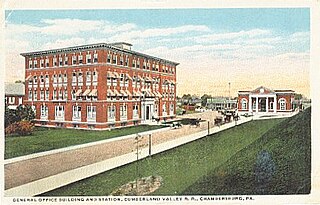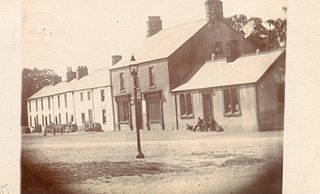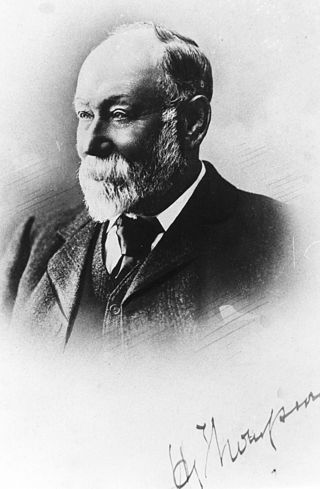
A dividend is a distribution of profits by a corporation to its shareholders, after which the stock exchange decreases the price of the stock by the dividend to remove volatility. When a corporation earns a profit or surplus, it is able to pay a portion of the profit as a dividend to shareholders. Any amount not distributed is taken to be re-invested in the business. The current year profit as well as the retained earnings of previous years are available for distribution; a corporation is usually prohibited from paying a dividend out of its capital. Distribution to shareholders may be in cash or, if the corporation has a dividend reinvestment plan, the amount can be paid by the issue of further shares or by share repurchase. In some cases, the distribution may be of assets.

Aspatria is a town and civil parish in Cumberland, Cumbria, England. The town rests on the north side of the Ellen Valley, overlooking a panoramic view of the countryside, with Skiddaw to the South and the Solway Firth to the North. Its developments are aligned approximately east–west along the A596 Carlisle to Workington road and these extend to approximately 2 miles (3.2 km) in length. It lies about 8 miles (13 km) northeast of Maryport, a similar distance to the Southwest of Wigton, about 9 miles (14 km) north of Cockermouth and 5 miles (8.0 km) from the coast and Allonby. It comprises the townships of Aspatria and Brayton, Hayton and Mealo, and Oughterside and Allerby, the united area being 8,345 acres (3,377 ha); while the town takes up an area of 1,600 acres (647 ha). In earlier days a Roman road leading from "Old Carlisle" to Ellenborough passed through the hamlet.

The Furness Railway (Furness) was a railway company operating in the Furness area of Lancashire in North West England.

The Maryport & Carlisle Railway (M&CR) was an English railway company formed in 1836 which built and operated a small but eventually highly profitable railway to connect Maryport and Carlisle in Cumberland, England. There were many small collieries in the area and efficient access to the harbour at Maryport was important.

The Cumbrian Coast line is a rail route in North West England, running from Carlisle to Barrow-in-Furness via Workington and Whitehaven. The line forms part of Network Rail route NW 4033, which continues via Ulverston and Grange-over-Sands to Carnforth, where it connects with the West Coast Main Line.

Bromfield is a village and civil parish in Cumbria, in the north of England.

Agricultural & General Engineers Limited (AGE) was a holding company formed on 4 June 1919 during a postwar economic "boom" to combine five British engineering companies: Aveling & Porter, E H Bentall, Blackstone, Richard Garrett and J & F Howard. The holding company's business was described to the judge considering its 1932 winding up as: "agricultural, transport, road, constructional and general engineers".

The Cumberland Valley Railroad was an early railroad in Pennsylvania, United States, originally chartered in 1831 to connect with Pennsylvania's Main Line of Public Works. Freight and passenger service in the Cumberland Valley in south central Pennsylvania from near Harrisburg to Chambersburg began in 1837, with service later extended to Hagerstown, Maryland, and then extending into the Shenandoah Valley to Winchester, Virginia. It employed up to 1,800 workers.

Harriston is a small hamlet in Cumbria, England, consisting of approximately 100 houses.
The Cockermouth & Workington Railway was an English railway company which built and operated a railway between the Cumberland towns of Workington and Cockermouth. The railway opened for service in 1847, and ran from the Whitehaven Junction Railway station at Workington to a station at Cockermouth near the bridge over the Derwent. A single-tracked line of eight and a half miles length, its revenue came largely from the transport of coal from the pits of the lower Derwent valley to the port at Workington for shipment by sea. The Marron extension of the Whitehaven, Cleator and Egremont Railway and the Derwent Branch of the Maryport and Carlisle Railway were both constructed to link with the C&WR and together give an alternative route for the northward movement of haematite ore from the Cumberland ore-field. The completion of the Cockermouth, Keswick and Penrith Railway made the C&WR part of a continuous through route between South Durham and the Cumberland orefield. These developments both improved the potential profitability of the C&WR, and made control of it important to bigger companies wishing to maximise the iron-ore traffic over their lines: the C&WR was absorbed by the London and North Western Railway in 1866.

A wheat pool is a co-operative that markets grain on behalf of its farmer-members.
The Whitehaven, Cleator and Egremont Railway was an English railway company which built and operated a standard gauge railway in Cumberland, England intended to open up the hematite orefield to the south-east of Whitehaven. It opened for goods traffic in 1855 and for passenger traffic in 1857.

William Lawson (1836–1916) was an English agriculturalist and pioneer co-operator. Lawson owned an experimental farm in Cumberland between the years 1862 and 1872.

Henry Thompson (MRCVS) (Member of the Royal College of Veterinary Surgeons; 1836–1920) was a founder member of the Aspatria Agricultural Society, the Aspatria Agricultural Cooperative Society and the Aspatria Agricultural College.

The Rev. William Slater Calverley (1847–1898) was an unassuming rural English vicar who through diligent study and painstaking scrutiny became an extraordinary amateur antiquarian. Although born in Leicestershire, Calverley claimed his fame through interpreting the carved sculptured relics that he and others found in Cumberland churchyards. He made intricate drawings, corresponded with academic authorities, and gave his own interpretations, which he then relayed to a wider audience. Calverley later produced in intricate detail a life-sized reproduction of the famous Gosforth Cross, which now stands in Aspatria churchyard.

Henry John Webb (1846–1893) was an English scholar, who became a trained botanist before moving into medicine. However, it was eventually agriculture and the training of scientific, practical agriculturalists that eventually caught his imagination. In 1887 he accepted the position of Principal to the Aspatria Agricultural College, a radical institution in the North of England, which a group of enthusiastic amateurs had established in 1874, for the purpose of training the sons of tenant farmers and farm labourers. In 1891 he became sole owner of the College, which he rebuilt and under his guidance it became one of the foremost seats of agricultural learning in England. He was also a successful world record holding cyclist and tricyclist.

The Provo West Co-op is a mercantile institution and also the name of its historic building in Provo, Utah. The Early Commercial-style building was listed on the National Register of Historic Places in 1984 as "Provo West Co-op".

Roland Stobbart, was an English speedway rider and promoter. He earned two international caps for the England national speedway team.

The Aspatria Agricultural College was a seat of learning located in Aspatria, Cumberland, England. Established in 1874, it was the second educational institution of its kind in the United Kingdom. It was unique in many respects, being devised, continuously revised, founded and funded by a small group of ordinary individuals. Although these rural gentlemen came from all shades of the political spectrum, they were men who combined across party lines and prejudices to promote an ideal. The College offered both two- and three-year courses in scientific and theoretical instruction along with practical work for both day or boarding students. It provided a wide range of academic agricultural related subjects integrated with traditional scientific subjects, including Business, Construction, Real Estate, Land Management and Dairy instruction. The College closed at the outset of the First World War and never re-opened.

St Kentigern's Church stands in the village of Aspatria, Cumbria, England. It is an active Anglican parish church in the rural deanery of Maryport, the archdeaconry of Carlisle and the diocese of Carlisle. The church has been designated by English Heritage as a Grade II* listed building. It is dedicated to St Kentigern, the apostle of Strathclyde, whom it is believed passed by and preached at the Holy well, on his way into exile in Wales, in the 6th century. He was also known as Mungo, which means good friend.


















